skip to main |
skip to sidebar
This report is based on information received from Doctor Hla Tun on 14-Jul-2016 and 20-Oct-2016 and 12-Jan-2017. He also supplied the photographs. The delay in posting this report is, I'm afraid, down to me.
My previous report showed monthly statistics up to the end of March, 2016, when the total number of treatments since the Clinic opened on August 6, 2011 was 169,211.
Treatment Summary
The table below summarises the number of treatments per month from April 2016 to December 2016 and the total number of treatments.
| Month |
Treatments in month |
Total treatments |
| April 2016 |
1,243 |
170,454 |
| May 2016 |
1,676 |
172,130 |
| June 2016 |
1,812 |
173,972 |
| July 2016 |
2,958 |
176,930 |
| August 2016 |
2,416 |
179,346 |
| September 2016 |
3,366 |
182,712 |
| October 2016 |
3,096 |
185,808 |
| November 2016 |
1,989 |
187,797 |
| December 2016 |
2,233 |
190,030 |
Bagan Medical Clinic Opening
The Bagan Medical Clinic is open throughout the year except for one or two weeks during April because of the Water Festival and Myanmar New Year.
Doctor Hla Tun is also Chief Medical Officer aboard the 'Road to Mandalay' river cruise ship operated by Belmond. During much of the season, this ship shuttles between Shwe Kyet Yet (near Mandalay) and Bagan, mooring at Bagan (close to the Bagan Clinic) from Friday to Monday, whilst the ship's guests explore the wonders of the pagodas spread across the Bagan Plain. This allows Doctor Hla Tun to open the Bagan Clinic on Friday, Saturday and Sunday. Working from 08:30 to 23:00 (with short breaks for food) Doctor Hla Tun typically sees 90 patients each day the Clinic is open. Less complex cases are seen by other doctors.
Free Lunches
A free lunch is served to patients and their companions on the clinic days (Friday, Saturday, Sunday).
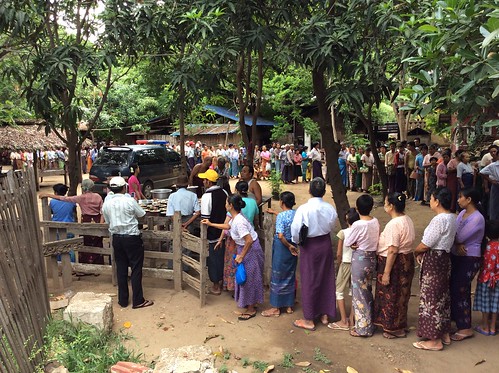
Free lunch being served to patients and their companions.
Donation of Children's Clothing
Donations of children's clothing are occasionally made to young patients.
Donation of Reading Glasses to elderly patients
Donations of Reading Glasses are occasionally made to elderly patients.
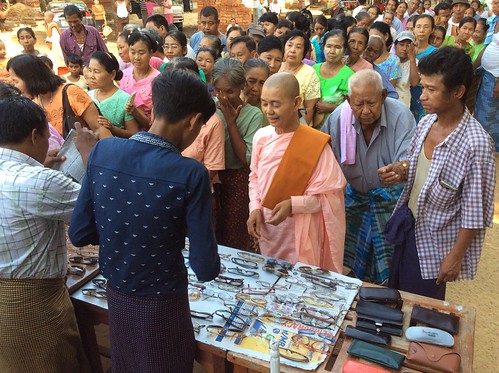
Bagan Clinic 2016: Distribution of reading glasses to elderly patients.
Health education talks
Health education talks are occasionally given to patients in the clinic by Doctor Hla Tun.
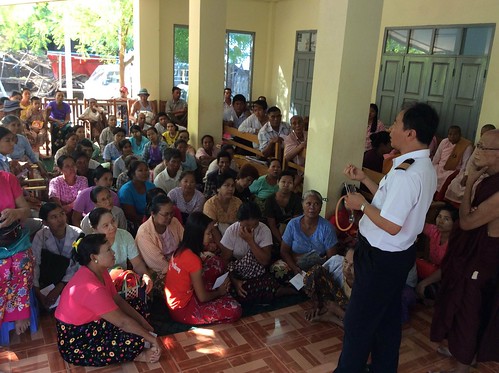
Doctor Hla Tun giving health education advice to patients at the clinic.
br>
Need for translators
Some patients travel long distances from the Delta, Rakhine State and Chin State to the Clinic. Translators are required for some of these ethnic groups because of the local dialects they use rather than standard Myanmar language.
Chin State, in Western Myanmar, is close to the Indian border and a patient from that area required a translator, as she couldn't understand the Myanmar language. This patient had facial tattoos, once common in the area.
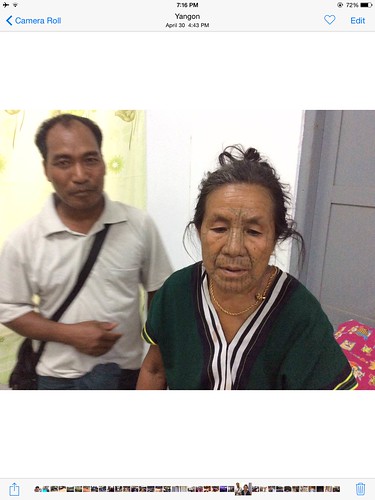
Patient from Chin State with facial tattoos.
New Equipment for Bagan Clinic
In May 2016, the generosity of two Guests funded the purchase of a new dental chair.

Bagan Clinic, May 2016: New Dental Chair.
Opening of Two Storey Clinic Building
Donors have provided funds for a 2-storey clinic building at the Bagan Clinic.

2-storey building under construction.
On 23rd September 2016, the two storey clinic building was opened. It includes rooms for a Dental Surgery, Eye Clinic, X-Ray Machine, UltraSound Machine, two Operating Theatres (one for eye surgery, one for general surgery) and two rooms to accommodate visiting doctors.

Opening of Two Storey Clinic Building
The opening was celebrated by a concert given by students.
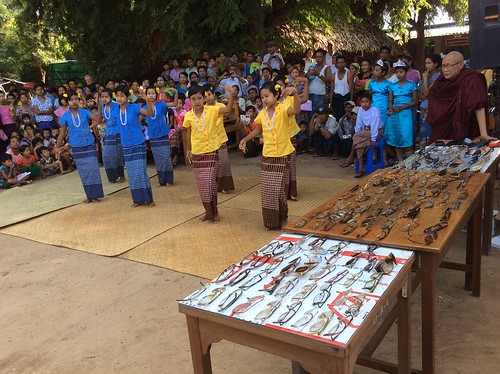
Opening of Two Storey Clinic Building, concert by students.
Individual Patient Stories
A lady who suffered from drooping of her upper eyelids could not afford to buy medicine and so she used tape or plaster between forehead and eyebrow at one end and upper eye lid at the other end to open her eyes. She was treated with eye drops.
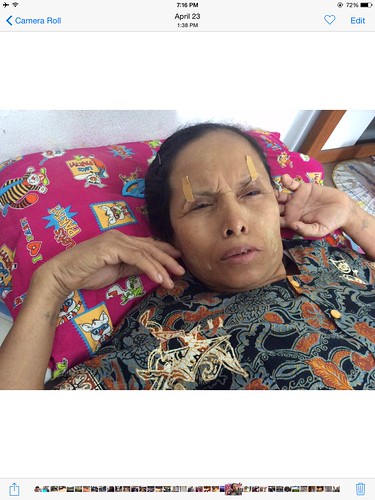
Patient with drooping eyelids.
A boy with muscle weakness on his right side improved his condition after medicine and physical exercise. He showed that he could kick a football.
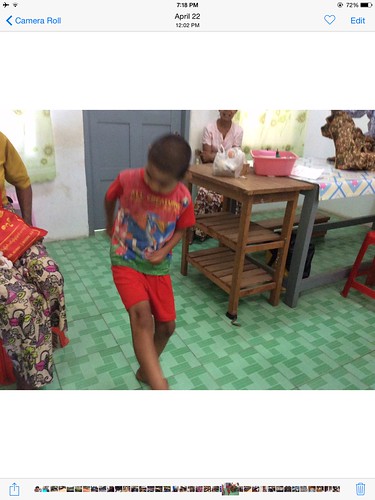
Young boy's improved condition after treatment.
In the previous update on Bagan Clinic here, we reported donations of anti-snake venom to hospitals. A particularly tragic case involving a snake bite concerns a lady from Chauk who earns a living collecting plums from under trees. Whilst collecting plums from a hole in the ground, she was bitten by a cobra. The local hospital injected anti-snake venom then she continued treatment with traditional medicine but developed a necrotic ulcer with exposed bone. Relatives and friends gave her money for transportation to Magway Divisional Hospital (about four hours away) for wound debridement treatment but she could not afford the transport costs for the necessary 3 or 4 follow-up treatments. Instead, she attended Bagan Medical Clinic where the cost of transport for further treatment at Magway (the equivalent of 8 Dollars U.S. per trip) was donated.
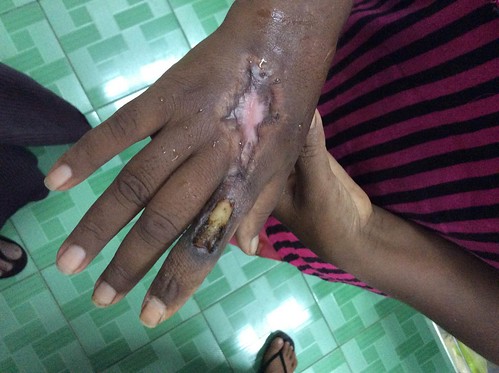
After-effects of a snake bite.
A 93 year old lady from SeikPhyu (about 60 miles from Bagan clinic) received supportive treatment and a donation of her transportation
fee and accommodation cost to allow her to receive treatment in Magway Divisional Hospital.
Patients with joint stiffness and pain can be helped by electrical stimulation of nerve and muscle and the use of a traction machine.
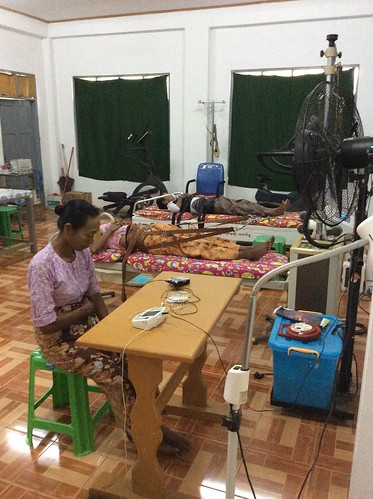
Electrical stimulation and traction treatment.
Special Medical Clinic Opening
On Monday, 26th September 2016 the 'Road to Mandalay' ship was 'stopped' at Bagan for a week, giving the Doctor the opportunity to open the clinic for a whole week. On the evening of Sunday 25th September, there were still some 350 patients waiting at the Clinic. Appointments were made for these waiting patients to return on a specific day to receive treatment. Patients who had travelled long distances were temporarily accommodated in the Bagan Monastery or at nearby monasteries. The Bagan Monastery was able to provide a free lunch every day and at least one free breakfast and one free dinner but patients accommodated elsewhere had to buy breakfast, lunch and dinner each day for up to five days, adding to the cost of their visit.
One couple from a remote area had borrowed money for food whilst waiting against the security of their gold ring but, when Doctor Hla Tun discovered this, he gave them the money to recover their ring.
Depending upon the distance travelled to reach the Clinic, transport can cost the equivalent of 5 - 20 Dollars U.S. per person and it's common to hear of a pig, goat, chicken or duck being sold to pay for transport.
During this week, Doctor Hla Tun asked a group of old ladies, who waited four days for treatment, why they had not gone back to their village about 50 miles away and returned on the day of the appointment. Their answer was that, once they'd paid to go home, they would be left with no money to return to the Clinic. Most of the group suffered from joint pain but the waiting additionally produced colds and coughs.
Other reports on medical support in Myanmar
There are a number of posts in this Blog describing medical support in Myanmar provided by the RTM Social Contribution with help from donors around the world. You can find them all here.
Photographs
There's a collection of pictures showing the Bagan Clinic from its inception here.
Doctor Hla Tun's photographs showing the work of the Bagan Clinic can be accessed by the following links:-
2014
2015
2016
As I wrote in the post 'Single-Wheeler' locomotives, early locomotives for passenger trains tended to have just a single-pair of driving wheels. This made the mechanism simpler and more free-running. Locomotives like 'Rocket' and the 'Planet' class had a single pair of moderately-large driving wheels to achieve fairly high-speed running on passenger trains. There's a little more in the post 'Planet' in Perspective, which outlines the use of four coupled wheels for freight locomotives where load haulage was more important than speed. There's much more about the history of the 'Planet' class (and the modern replica locomotive at the Museum of Science and Industry in Manchester) here.
Later designers used even larger driving wheels to achieve higher speed without increasing piston speed. But large driving wheels required great skill on the part of the driver to get trains started under less than ideal conditions without excessive slipping.
Patrick Stirling of the Great Northern Railway remained a staunch advocate of 'Singles', such as his famous class of 4-2-2 engines with 8 foot 1 inch diameter driving wheels, introduced in 1870.

Preserved Stirling 4-2-2 displayed at Doncaster in 2003 (Photo: Our Phellap).
When Dugald Drummond was at the Caledonian Railway, he too produced very successful 'Singles', like the 4-2-2 '123' with 7 foot drivers built in 1886.
 Preserved Drummond 4-2-2 '123' (Photo: Glasgow Museums).
Preserved Drummond 4-2-2 '123' (Photo: Glasgow Museums).
The growth of passenger demand meant that there was continual pressure to increase the loads hauled and many locomotive designers turned to four-coupled designs, where the torque delivered to the two wheels of the driving axle by the connecting rods was shared, through coupling rods, with a similar pair of wheels which became 'coupled wheels'.
The locomotive designer Patrick Stirling was not convinced, famously claiming, in his Scottish accent, that "A coupled engine is like a laddie running with his breeks [trousers] down". Certainly, the success of coupling wheelsets together depends upon the accuracy with which the crankpins are set, referred to as 'quartering' - inaccuracies will produce a 'stiffness' in the mechanism which may be tolerable in a freight engine not expected to travel at high speed but is unacceptable in an express design.
In the early days of locomotive building there were problems in achieving the desirable accuracy but by 1896, when Johnson produced his handsome '115' class 'Singles' for the Midland Railway, production techniques had evolved sufficiently for the four-coupled passenger locomotive to have become common. Johnson's later designs for the Midland featured the 4-4-0 wheel arrangement which persisted for express locomotives on the Midland and L.M.S. until the Stanier era.
Dugald Drummond
Dugald Drummond (1840-1912) was born in Ardrossan and served an engineering apprenticeship in Glasgow before gaining further exoerience on Scottish railways. After managing the Birkenhead boiler shop of Thomas Brassey, in 1864 he moved to Cowlairs railway works under Samuel Waite Johnson (later of the Midland Railway). He then became Foreman Erector at the Inverness works of the Highland Railway under William Stroudley. When Stroudley moved to the L.B.S.C.R., Drummond followed as his assistant before taking up the post of Locomotive Superintendent of the North British in 1875. In 1882 Drummond moved to the Caledonian Railway before an unsucessful private locomotive building venture in Australia, followed by a time back in Scotland at the Glasgow Railway Engineering Company. He was Locomotive Engineer (later titled Chief Mechanical Engineer) of the London and South Western Railway from 1895 until his tragic death in 1912. He appears to have been outspoken and difficult throughout his career but is recognised as an important locomotive engineer.
His younger brother, Peter, also had a significant career as a locomotive designer.

Picture of the older Dugald Drummond (Wikipedia).
The Drummond 'T9'
In the 'C8' class, Drummond designed an inside-cylinder 4-4-0 with 6 foot 7 inch diameter coupled wheels and a 9 foot coupled wheelbase, similar to earlier designs he'd produced for the North British and Caledonian railways. The 'T9' which immediately followed was intended to increase steaming capacity by lengthening the coupled wheelbase to 10 feet, allowing a larger grate. In Scotland, Drummond had learnt the value of rugged, reliable construction and the 'T9' embodied these principles with 1 inch thick steel frames. Between 1899 and 1901, 66 engines were built in three batches, paired with either a 6-wheel or 8-wheel 'Watercart' tender. Early engines featured a narrow cab and in addition to normal splashers on the coupled wheels which incorporated sandboxes, smaller splashers were provided to clear the coupling rods and crankpins. The third batch of engines built had wider cabs with matching splashers, removing the need for coupling rod splashers and conventional sandboxes were substituted. Vacuum brakes were standard (although at least two had air brakes as well).
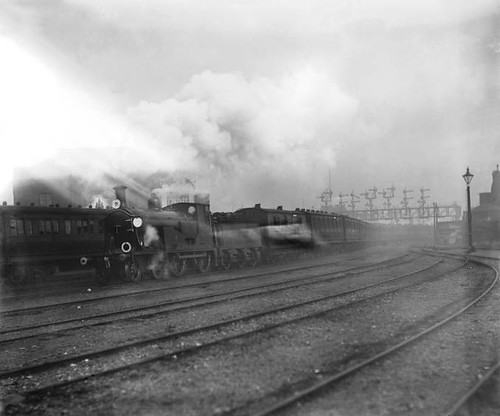
'T9' number 307 as originally built and running with a 6-wheel tender seen leaving Waterloo with a Southampton Boat Train, around 1902 (Photo: NRM Nine Elms Collection: Creative Commons)
Drummond had acquired from Stroudley a dislike of unnecessary boiler piercings so the two lock-up safety valves were placed atop the dome - a very distinctive feature. Drummond was not enthusiastic about superheating but he did increase the boiler working pressure on the 'T9' to 175 p.s.i. Enginemen were then encouraged to adjust the 'cut off' to achieve best economy by using the steam expansively. Drummond was an "engineman's engineman", familiar with work on the footplate, although his demeanour could be fierce. He gave lectures to footplatemen at a number of sites. These lectures were later published as a pocket reference book.
The Drummond arrangement of Stephenson Link Motion operating slide valves was regarded as particularly successful and free-running. The fitting of a steam reverser made frequent adjustments to the 'cut off' an easy task.
Eastleigh drawing E34 below shows the original appearance of the first batch of twenty locomotives, built at Nine Elms.

Eastleigh drawing E34: 'T9' (shows 8-wheel tender).
Click here for larger view.
Although Drummond did not embrace superheating, he was anxious to maximise steam generation and he introduced various water tube arrangements to his boilers. The second batch of thirty 'T9', built by Dubs (there's a short history of Dubs here) incorporated two groups of water cross tubes in the firebox. With or without water tubes, the class performed well.
In 1922, Urie rebuilt number 314 with an Eastleigh pattern superheater, extended smokebox and stovepipe chimney. Subsequently, the rest of the class received these changes, generally giving the appearance shown in Eastleigh drawing E34B below. After 1925, the Maunsell superheater replaced the Eastleight pattern.

Eastleigh drawing E34B: 'T9' as rebuilt (shows 6-wheel tender).
Click here for larger view.
The T9 was liked by enginemen and came to be regarded as Drummond's 'masterpiece'. The class had a long life - none were withdrawn until the 1950s and the last (number 120 from 1899, renumbered 30120 by British Railways) survived until 1963 when it became part of the National Collection managed by National Railway Museum.
On Saturday 8th April 2017, I finally got to drive the National Collection's 'T9' at the Battlefield Line. But that's another story.
 Drummond 'T9': 30120 being prepared at Shackerstone on 8th April 2017.
Drummond 'T9': 30120 being prepared at Shackerstone on 8th April 2017.
Book References
[1] ‘Drummond Locomotives – A Pictorial History’ by Brian Haresnape and Peter Rowledge (Ian Allen 1982) ISBN 0 7110 1206 7.
[2] ‘A Pictorial Record of Southern Locomotives’ by J. H. Russell (Haynes Publishing 1991).
[3] ‘Great Locomotives of the Southern Railway’ by O. S. Nock (Guild Publishing).
Related posts on other sites
Dugald Drummond (Wikipedia).
Dugald Drummond (Grace's Guide).
Dugald & Peter Drummond (Steam Index).
Related posts on this site
'Single-Wheeler' locomotives.
'Planet' in Perspective.
My Pictures
Where necessary, clicking on an image above will display an 'uncropped' view or, alternately, pictures may be selected, viewed or downloaded, in various sizes, from the album listed:-
Drummond 'T9'.
[Old picture added, corrections: 17-Apr-2017]



















